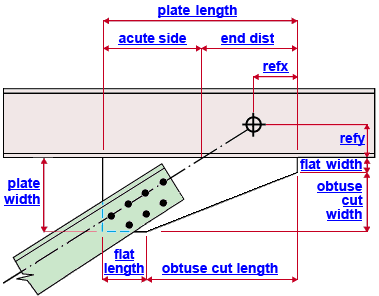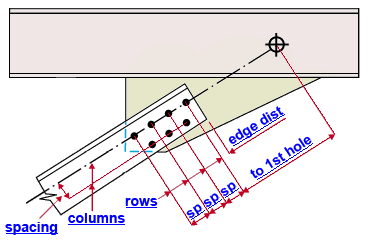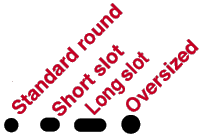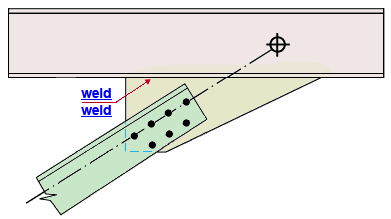"  Gusset One Member Square " & "
Gusset One Member Square " & "  Brace Connection To Gusset " & "
Brace Connection To Gusset " & "  Weld Conn2 "
Weld Conn2 "
| An angle, W tee or channel vertical brace field bolts directly to a gusset plate per choices made to " |
|
|||
| " (gusset plate dimensions and location)  |
" (holes for field bolting the brace to the gusset)  |
||
|
" |
|
||
Connection Guide: Click here , here or here .
User Defined Connections: Settings that are locked (
) in the user defined connection file will automatically be locked on the member edit window. You can, if you so choose, manually lock additional settings on the member edit window, and your changes will be retained, through multiple processes, so long as you do not change to a different connection then switch back to the original user defined connection.
Vertical Brace Edit: To change a setting, first set it to locked (
). Related settings that are unlocked (
) may be updated, and the "
Left/Right end limit state " calculations will be updated. Settings that are locked (
) will not be changed by connection design , even if doing so might prevent a connection failure.
Connection design locks :
| Locks not dimensioned or called out on the drawing are marked ( not depicted ). |
![]() Gusset One Member Square
Gusset One Member Square
(angle vertical brace to a beam)
(" Clip end operation " = ' No ' or possibly ' Automatic ')
Gusset plate dimensions and location
Plate thickness ( not depicted ): The " Material thickness " of the gusset plate material.
Width ( plate width ): For a gusset plate fastened to a non-sloping beam, this is the vertical distance (perpendicular to the beam's work line ) between the two horizontal edges of the gusset plate (see example ). For a gusset to a sloping beam, this distance is measured perpendicular with the slope of the beam (that is, perpendicular to the framing edge of the gusset plate). " Plate Width " can also be defined as the length of the edge of the gusset plate that is perpendicular to the work line of the supporting beam.
Length ( plate length ): The length of the longest edge of the gusset plate. In the example shown, this is the edge that welds to the bottom flange of the beam. This distance is measured parallel with the slope of the beam. For a non-sloping beam, this distance is perfectly horizontal.
Refx: The positive (+) or negative (-) distance parallel with the supporting beam's work line from the work point for this end of the vertical brace to the corner of the framing edge of the gusset plate that this end of the vertical brace points toward (see example ). For a gusset plate to a non-sloping beam, this distance is perfectly horizontal. An " Refx " of ' 0 ' aligns the corner of the gusset plate with the brace's work point. Entering a positive (+) distance moves the corner of the gusset plate parallel with the beam's work line in the direction that this end of the vertical brace points toward. Entering a negative (-) distance moves the gusset plate parallel with the beam's work line toward the opposite end of the vertical brace. Changing the " Refx " will move the plate, but does not move the holes on the plate.
Refy: The positive (+) or negative (-) distance perpendicular to the supporting beam's work line from the work point for this end of the vertical brace to the framing edge of the gusset plate (which welds to the beam's bottom flange in the example shown). For a gusset plate to a non-sloping beam, this distance is perfectly vertical. A " Refy " of ' 0 ' aligns the framing edge of the gusset plate with the work point. Entering a positive (+) distance moves the gusset plate perpendicular to the beam's work line toward the opposite end of the vertical brace. Entering a negative (-) distance moves the gusset plate perpendicular to the beam's work line in the direction that this end of the vertical brace points toward. Changing the " Refy " moves the plate, but does not move the holes on the plate.
Obtuse side clip cut width ( obtuse cut width ): The distance (perpendicular to the work line of the supporting beam) between the two corners of clip cut made to the obtuse side of the gusset plate. The obtuse side of the gusset plate is the side contained by the obtuse angle between the beam and the brace. See the example .
Obtuse side clip cut length ( obtuse cut length ): The distance (parallel to the work line of the supporting beam) between the two corners of the clip cut made to the obtuse side of the gusset plate. The obtuse side of the gusset plate is the side contained by the obtuse angle between the beam and the brace. See the example .
Flat width: The distance (perpendicular to the work line of the supporting beam) that is the width of the cut that is made to the corner of the gusset plate that the work line of the brace points toward. In the example above, the " Flat width " cut is made to the corner of the gusset plate that is closest to the brace's work point.
Flat length: The actual length of the cut made to create an edge that is parallel to and opposite to the framing edge of the gusset plate. Cut length is always measured parallel with the length of the gusset plate. See the example .
End distance ( end dist ): The positive distance parallel with the framing edge of the gusset plate (the edge that welds to the bottom flange of the supporting beam in the example shown) from the point where the work line of the brace intersects the framing edge of the gusset plate to the corner of the framing edge that this end of the vertical brace points toward.
Length acute side ( acute side ): The distance (parallel to the work line of the supporting beam) from the acute-side corner of the framing edge of the gusset plate to the work line of the brace. The framing edge has two corners. The acute-side corner is the corner of the framing edge that is interior to the acute angle formed by the work line of the brace to the work line of the beam (see example ).
![]() Brace Connection To Gusset
Brace Connection To Gusset
(L or WT or C vertical brace, to a beam)
Brace to gusset plate connection ( field bolted )
Bolt diameter ( not depicted ): You can either type in any diameter (inches or mm), or select a bolt diameter from the combo box (
). The diameters that are listed in the combo box come from Home > Project Settings > Job > Bolt Settings > the " Available bolt diameters " list. The bolt diameter entered here, together with the " Hole type " entered below, set the diameter of holes the bolts go into.
Hole type ( not depicted ): Standard round or Short slot or Oversized or Long slot or User slot #1 or User slot #2 . This sets the hole type selected here, together with the " Bolt diameter " entered above, set the diameter of holes for field bolting the brace to the gusset plate.

Rows: The number of holes in the column of holes with the greatest number of holes. Row spacing on a vertical brace gusset plate runs parallel with the work line of the vertical brace. For an angle vertical brace, this is the number of rows of holes in the column of holes along the work line of the brace. For vertical braces of other types of material, this is the number of rows in any one column of holes. Entering ' 0 ' removes the holes. For the angle brace shown in the example above, the number of " Rows " is ' 4 '.
Distance to 1st hole along brace ( to 1st hole ): The distance (parallel with the work line of the brace) from the work point to the center of the nearest row of holes. For the example above (an angle brace with staggered bolts), the nearest row of holes is the nearest hole on the work line.
Hole spacing along brace ( sp ): Row spacing. This is the distance (center to center) between of any two adjacent holes in the same column of holes (see example ).
End connection failure message: Invalid bolt spacing
Edge distance along brace ( edge dist ): The distance from the forward edge of the brace to the nearest hole for field bolting that brace to the gusset plate (see example ). The forward edge of the brace is the edge that is closest to the work point of the brace.
Columns: The number of columns of holes through the gusset plate. These holes will be used for field bolting the vertical brace to the gusset. Column spacing runs perpendicular to the work line of the vertical brace. In the example above, the number of " Columns " is ' 2 '.
Distance to 1st hole perpendicular to brace ( not depicted ): The distance from the work line of the vertical brace perpendicular to the nearest column of holes. In the example above, this distance would be ' 0 ' (zero) since the nearest column of holes is centered over the work line of the brace.
Hole spacing perpendicular to brace ( spacing ): Column spacing. This is the distance (measured center to center) between any two columns of holes (see example ). If you want only a single column of holes, enter ' 0 ' as the " Column spacing ." Column spacing runs perpendicular to the work line of the vertical brace.
![]() Weld Conn2
Weld Conn2
(L or WT or C vertical brace to a beam)
Shop weld, gusset plate to the supporting beam
Weld size ( weld ): The weld size for shop welding the gusset plate to the supporting beam. In the example above, the gusset plate shop welds to the beam, but you can optionally shop bolt the gusset with a clip angle ("
NS/FS Clip Conn2 "). Regardless of whether the gusset is shop welded or shop bolted to the beam, it is detailed with the beam and field bolts to the vertical brace.
|
To get a weld (" To instead get a clip angle (" |








